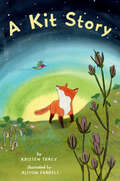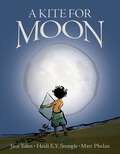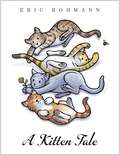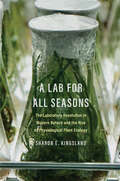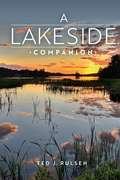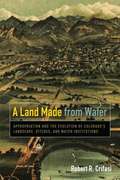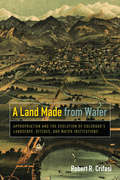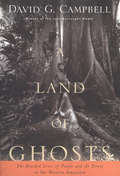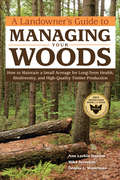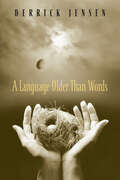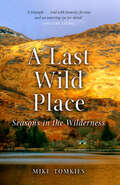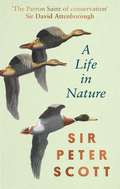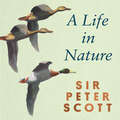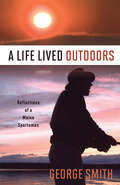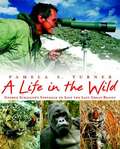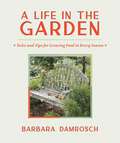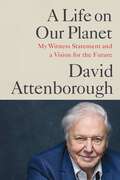- Table View
- List View
A Kit Story
by Kristen Tracy Alison FarellAlison Farrell's The Hike meets Richard Scarry's I Am a Bunny in this delightful board book that combines sweetness and science.I am a fox. Do you see me?Timeless and nostalgic, quirky and fresh, lightly educational and wholly heartfelt, this autobiography of a fox kit will delight all cuddlers and snugglers.See the world through a fox kit's eyes in a charming book about finding your place in the world. Over the course of four seasons, Kit comes of age in the forest. In spring, she gambols. In autumn, she races. In summer, she sneaks and slinks. But with her mama, she will always be a little kit.This is the second in a series of board books that pairs Kristen Tracy's enchanting, playful text with Alison Farrell's sweet, endearing art for an adorable treatment of everyone's favorite topic: baby animals!PERFECT FOR BEDTIME KISSES: The story goes through a day in the life of a baby fox kit and ends tucked into her den with her mama fox. It's the perfect book to take families through their own day, complete with a cozy goodnight moment!ENCOURAGES CHILDREN TO IMAGINE OTHER PERSPECTIVES: This book is told in the first person: "I am a fox." The unusual narrator will get the youngest readers thinking about what it's really like to be a little fox kit!TEACHES COMPARISONS: The idea of seeing through the animal's eyes using comparisons to familiar ideas (Kit is slower than a hummingbird but faster than a turtle) is a perfect introduction to comparative logic.TEACHES SEASONS: Readers will delight in following Kit through all four seasons of the year, learning what she does differently in spring than she does in summer, what she does for the first time in autumn, and how she experiences winter.CRITICALLY ACCLAIMED ILLUSTRATOR: Alison Farrell is the author-illustrator of the fan favorite The Hike, along with Cycle City, Bicycle Bash, and A Cub Story, the first book in this series. Here she brings her love of science and sweet animals to a brand-new series about forest critters!BABY ANIMALS! There's one thing all babies love: baby animals! There are all kinds of animals to look at and learn about in these pages filled with wildlife and with love. Careful eyes will spot animals hidden everywhere in the detail-rich, evocative scenes.A BOOK TO BOND OVER: This is the perfect cuddly read between baby and parent, since it's focused on baby animals and their families.Perfect for:• Parents• Grandparents• Friends searching for the perfect baby shower gift• Animal lovers
A Kite for Moon
by Jane Yolen Heidi E.Y. StempleDedicated to astronaut Neil Armstrong, A Kite for Moon is the perfect children&’s book to help celebrate the 50th anniversary of the first United States moon landing. Written by New York Times bestselling author of How Do Dinosaurs Say Goodnight? Jane Yolen and her daughter, Heidi Stemple, this book is a heartfelt story about a young boy&’s fascination and unlikely friendship with the moon.What would it be like if the moon was your friend? Find out as you walk alongside a little boy who journeys through life to achieve his dream of becoming an astronaut. And then blast off with your little one as you zoom to the moon together!The story begins when a little boy, who is flying his kite, notices a sad Moon. He sends up kites to her, writing notes promising he will come see her someday. This promise propels him through years of studying, learning, and training to become an astronaut. Until … he finally goes up, up, up in a big rocket ship with a fiery tail.A Kite for Moon:Features over 20 gorgeous illustrations by award-winning artist Matt PhelanIs the perfect storybook for children ages 4 to 8Celebrates every child&’s fascination with space
A Kitten Tale
by Eric RohmannFour kittens have never seen the snow. The first three kittens are wary--snow is cold, it's wet, it covers everything. This unknown thing called snow is a little bit. . . scary. As the seasons pass and winter begins to loom, the three skittish kittens worry. But the fourth kitten takes a different view. The fourth kitten is getting excited. Snow will cover everything?! "I can't wait!"Caldecott Medal winner Eric Rohmann gives us a charming, gentle story that both respectfully acknowledges a child's fear of the unknown and celebrates the power of a positive outlook. Deceptively simple and quietly profound.
A Lab for All Seasons: The Laboratory Revolution in Modern Botany and the Rise of Physiological Plant Ecology
by Sharon E. KingslandThe first book to chronicle how innovation in laboratory designs for botanical research energized the emergence of physiological plant ecology as a vibrant subdiscipline Laboratory innovation since the mid-twentieth century has powered advances in the study of plant adaptation, evolution, and ecosystem function. The phytotron, an integrated complex of controlled-environment greenhouse and laboratory spaces, invented by Frits W. Went in the 1950s, set off a worldwide laboratory movement and transformed the plant sciences. Sharon Kingsland explores this revolution through a comparative study of work in the United States, France, Australia, Israel, the USSR, and Hungary. These advances in botanical research energized physiological plant ecology. Case studies explore the development of phytotron spinoffs such as mobile laboratories, rhizotrons, and ecotrons. Scientific problems include the significance of plant emissions of volatile organic compounds, symbiosis between plants and soil fungi, and the discovery of new pathways for photosynthesis as an adaptation to hot, dry climates. The advancement of knowledge through synthesis is a running theme: linking disciplines, combining laboratory and field research, and moving across ecological scales from leaf to ecosystem. The book also charts the history of modern scientific responses to the emerging crisis of food insecurity in the era of global warming.
A Lakeside Companion
by Ted J. RulsehWhy do fish jump? Why don't lakes freeze all the way down to the bottom? Which lake plants are invasive? What are those water bugs? Is that lake healthy? Whether you fish, paddle, swim, snowshoe, ski, or just gaze upon your favorite lake, A Lakeside Companion will deepen your appreciation for the forces that shape lakes and the teeming life in and around them. You'll discover the interconnected worlds of a lake: the water; the sand, gravel, rocks, and muck of the bottom; the surface of the lake; the air above; and the shoreline, a belt of land incredibly rich in flora and fauna. Explained, too, are the physical, biological, and chemical processes that determine how many and what kinds of fish live in the lake, which plants grow there, the color and clarity of the water, how ice forms in winter and melts in spring, and much more. Useful advice will help you look out for your lake and advocate for its protection.
A Land Made from Water
by Robert R. Crifasi"A Land Made from Water chronicles how the appropriation and development of water and riparian resources in Colorado changed the face of the Front Range--an area that was once a desert and is now an irrigated oasis suitable for the habitation and support of millions of people. This comprehensive history of human intervention in the Boulder Creek and Lefthand Creek valleys explores the complex interactions between environmental and historical factors to show how thoroughly the environment along the Front Range is a product of human influence.Author Robert Crifasi examines the events that took place in nineteenth-century Boulder County, Colorado, and set the stage for much of the water development that occurred throughout Colorado and the American West over the following century. Settlers planned and constructed ditches, irrigation systems, and reservoirs; initiated the seminal court decisions establishing the appropriation doctrine; and instigated war to wrest control of the region from the local Native American population. Additionally, Crifasi places these river valleys in the context of a continent-wide historical perspective.By examining the complex interaction of people and the environment over time, A Land Made from Water links contemporary issues facing Front Range water users to the historical evolution of the current water management system and demonstrates the critical role people have played in creating ecosystems that are often presented to the public as "natural" or "native." It will appeal to students, scholars, professionals, and general readers interested in water history, water management, water law, environmental management, political ecology, or local natural history."
A Land Made from Water: Appropriation and the Evolution of Colorado's Landscape, Ditches, and Water Institutions
by Robert R. CrifasiA Land Made from Water chronicles how the appropriation and development of water and riparian resources in Colorado changed the face of the Front Range—an area that was once a desert and is now an irrigated oasis suitable for the habitation and support of millions of people. This comprehensive history of human intervention in the Boulder Creek and Lefthand Creek valleys explores the complex interactions between environmental and historical factors to show how thoroughly the environment along the Front Range is a product of human influence. Author Robert Crifasi examines the events that took place in nineteenth-century Boulder County, Colorado, and set the stage for much of the water development that occurred throughout Colorado and the American West over the following century. Settlers planned and constructed ditches, irrigation systems, and reservoirs; initiated the seminal court decisions establishing the appropriation doctrine; and instigated war to wrest control of the region from the local Native American population. Additionally, Crifasi places these river valleys in the context of a continent-wide historical perspective. By examining the complex interaction of people and the environment over time, A Land Made from Water links contemporary issues facing Front Range water users to the historical evolution of the current water management system and demonstrates the critical role people have played in creating ecosystems that are often presented to the public as “natural” or “native.” It will appeal to students, scholars, professionals, and general readers interested in water history, water management, water law, environmental management, political ecology, or local natural history.
A Land of Ghosts: The Braided Lives of People and the Forest in Far Western Amazonia
by David G. CampbellThe biologist and award-winning author journeys deep inside the Amazon rainforest in this eloquent and insightful look at one of earth’s last wild places.For thirty years, biologist David G. Campbell has been exploring the lush wilderness, of the western Amazon, which contains more species than ever existed anywhere on our planet. In A Land of Ghosts, Campbell takes readers on his latest venture.In Cruzeiro do Sul, 2,800 miles from the mouth of the Amazon, Campbell collects three old friends: Arito, a caiman hunter turned paleontologist; Tarzan, a street urchin brought up in a bordello; and Pimentel, a master canoe pilot. Heading further into the rainforest, they survey every living woody plant they can find. The land is so rich that an area of less than fifty acres contains three times as many tree species as all of North America.Campbell knows the trees individually, and he knows the wildlife and the people as well: the recently arrived colonists with their failing farms; the Caboclos, masters of hunting, fishing, and survival; and the refugee Native Americans. These people live in a land whose original inhabitants were wiped out by centuries of disease, slavery, and genocide, taking their traditions and languages with them: a land of ghosts.
A Landowner's Guide to Managing Your Woods: How to Maintain a Small Acreage for Long-Term Health, Biodiversity, and High-Quality Timber Production
by Anne Larkin Hansen Mike Severson Dennis L. WatermanWhether you have a few acres of trees in the suburbs or a small commercial forest, you can encourage a healthy and sustainable ecosystem through proper woodland management. This introductory guide shows you how to identify the type, health, and quality of your trees and suggests strategies for keeping your woodland thriving.
A Language Older Than Words
by Derrick JensenAt once a beautifully poetic memoir and an exploration of the various ways we live in the world, A Language Older Than Words explains violence as a pathology that touches every aspect of our lives and indeed affects all aspects of life on Earth. This chronicle of a young man's drive to transcend domestic abuse offers a challenging look at our worldwide sense of community and how we can make things better.
A Last Wild Place: Seasons in the Wilderness
by Mike TomkiesWhen Mike Tomkies moved to a remote cottage on the shores of Loch Shiel in the West Highlands of Scotland, he found a place which was to provide him with the most profound wilderness experience of his life. Accessible only by boat, the cottage he renamed ‘Wildernesse’ was to be his home for many years, which he shared with his beloved German Shepherd, Moobli. Centred on different landscape elements – loch, woodlands and mountains –Tomkies describes the whole cycle of nature through the seasons in a harsh and testing environment of unrivalled beauty. Vivid colours and sounds fill the pages – exotic wild orchids, the roar of rutting stags, the territorial movements of foxes, otters and badgers, an oak tree being torn apart by hurricane-force gales. Nothing escapes his penetrating eye. His extraordinary insights into the wildlife that shared his otherwise empty territory were not gained without perseverance in the face of perilous hazards, and the difficulties and challenges of life in the wilderness are a key part of this remarkable book.
A Lawless Place: A Contraband Shore Novel (The Contraband Shore)
by David DonachieThe second volume in The Contraband Shore trilogy.1787: Captain Edward Brazier is devastated to find Betsey, the woman he wants to marry, imprisoned in her own home by her brother, Henry Tulkington, and trapped in an illegal marriage. With Brazier suspected of acting as a spy for a prime minister seeking to halt smuggling activity on the coast and still posing a threat to Betsey&’s increasingly deranged brother, he is walking a dangerously fine line.But Tulkington&’s arrogance is making him enemies, even in his own family, and his actions are becoming increasingly violent towards everyone who thinks to defy him. Brazier's only option is to join with the darker denizens of Deal in the hope of constructing an alliance which will see his lady freed.
A Lenda de Ron Añejo
by Ed TejaRon é o melhor malandro de barcos do mar caribenho. Com sua base na ilha fictícia tropical de Kayak, ele vive uma vida gloriosa com um orçamento extremamente apertado, sendo capaz de conseguir pelo menos rum e comida. Com um otimismo inabalável, ele confronta o mundo e, enquanto ele tiver o seu barco de madeira esburacado, ele consegue se divertir independente de qual seja o próximo desastre.
A Less Green and Pleasant Land
by Norman MacleanDisentangling the facts from the hype, this 'Domesday book' of the British and Irish countryside offers a definitive and up-to-date survey of the state of our wildlife today. Norman Maclean, editor of the bestselling Silent Summer, examines the latest findings of Britain and Ireland's top wildlife experts and interprets them for a wider audience. Each chapter provides reliable estimates of animal populations, showing which species are thriving and which are in decline. The book also considers the effects of climate change on our wildlife and how human population growth is influencing its development. Beautifully illustrated with colour plates and wood engravings throughout, this accessible and timely study reveals just how rapidly our countryside and its wildlife are changing, why we should be concerned, and what we can do about it.
A Letter to My Cat: Notes to Our Best Friends
by Lisa ErspamerThe follow-up to A Letter to My Dog takes on cats, with celebrities writing letters of love and gratitude to their beloved pet felines. Alluring, elusive, mysterious—the cats in our lives are not always easy to get to know. But as with all pets, they have unique personalities and stories to tell. Alongside beautiful four-color photos of their cats, A Letter to My Cat collects personal letters from celebrities offering love and gratitude for all that their cats bring to their lives.
A Letter to My Dog: Notes to Our Best Friends
by Lisa Erspamer Kimi Culp Robin LaytonDogs know how to talk to us they do it all the time. A pair of raised ears or a wagging tail can speak volumes to those in the know. In this heartfelt ode to the furriest of family members, dog lovers get the chance to say something back, sharing personal letters penned to their beloved companions. With gorgeous accompanying photographs by Robin Layton, this collection of letters and portraits features a wide range of dogs and their owners, including everyday people with remarkable stories as well as celebrities like Hilary Duff, Tony Bennett, and Oprah Winfrey alongside their pooches. Throughout, these tales of perseverance, love, and loyalty celebrate the deep and devoted friendships that humans share with their pups.
A Letter to My Grandchildren
by David SuzukiAn exclusive excerpt of one letter from David Suzuki's forthcoming book Letters to My Grandchildren. In the book, Suzuki offers grandfatherly advice to his five grandchildren, recounts stories from his own childhood, and explores what makes life meaningful. As he ponders life's deepest questions and offers up a lifetime of wisdom, Suzuki inspires us all to live with courage, conviction, and passion.All proceeds from the sale of this exclusive advance will be donated to the David Suzuki Foundation.
A Life In Nature
by Peter Scott'The Patron Saint of Conservation' Sir David Attenborough'Peter Scott was a huge influence on my childhood...Later on in life I had the good fortune both to meet and to interview him, and he remains, for me, a hero. His knowledge, his kindness to me and his generosity of spirit have remained an influence in my own sphere of natural history....To meet one's heroes can sometimes be a let-down. That was most certainly not the case with Peter Scott.' Alan TitchmarshA Life In Nature is a portrait of Peter Scott collected from his own conversations, articles and broadcasts including thoughts on expeditions to Lapland, Conservation and Africa, his travels in Europe and much more. Illustrated by Peter's own beautiful illustrations. Sir Peter Scott had a truly incredible life. He was the only son of legendary explorer Captain Scott. His godfather was JM Barrie and he was married to Elizabeth Jane Howard. He also represented Great Britain and Northern Ireland at sailing in the 1936 Berlin Olympic Games, winning a bronze medal. He founded the Wildfowl and Wetlands Trust and also helped to found the Worldwide Fund for Nature.This is a beautiful and timely re-discovered book, perfect for those who are interested in preserving our planet.
A Life In Nature
by Sir Peter Scott'The Patron Saint of Conservation' Sir David Attenborough'Peter Scott was a huge influence on my childhood...Later on in life I had the good fortune both to meet and to interview him, and he remains, for me, a hero. His knowledge, his kindness to me and his generosity of spirit have remained an influence in my own sphere of natural history....To meet one's heroes can sometimes be a let-down. That was most certainly not the case with Peter Scott.' Alan TitchmarshA Life In Nature is a portrait of Peter Scott collected from his own conversations, articles and broadcasts including thoughts on expeditions to Lapland, Conservation and Africa, his travels in Europe and much more. Illustrated by Peter's own beautiful illustrations. Sir Peter Scott had a truly incredible life. He was the only son of legendary explorer Captain Scott. His godfather was JM Barrie and he was married to Elizabeth Jane Howard. He also represented Great Britain and Northern Ireland at sailing in the 1936 Berlin Olympic Games, winning a bronze medal. He founded the Wildfowl and Wetlands Trust and also helped to found the Worldwide Fund for Nature.This is a beautiful and timely re-discovered book, perfect for those who are interested in preserving our planet.
A Life In Nature
by Sir Peter Scott'The Patron Saint of Conservation' Sir David Attenborough'Peter Scott was a huge influence on my childhood...Later on in life I had the good fortune both to meet and to interview him, and he remains, for me, a hero. His knowledge, his kindness to me and his generosity of spirit have remained an influence in my own sphere of natural history....To meet one's heroes can sometimes be a let-down. That was most certainly not the case with Peter Scott.' Alan TitchmarshA Life In Nature is a portrait of Peter Scott collected from his own conversations, articles and broadcasts including thoughts on expeditions to Lapland, Conservation and Africa, his travels in Europe and much more. Illustrated by Peter's own beautiful illustrations. Sir Peter Scott had a truly incredible life. He was the only son of legendary explorer Captain Scott. His godfather was JM Barrie and he was married to Elizabeth Jane Howard. He also represented Great Britain and Northern Ireland at sailing in the 1936 Berlin Olympic Games, winning a bronze medal. He founded the Wildfowl and Wetlands Trust and also helped to found the Worldwide Fund for Nature.This is a beautiful and timely re-discovered book, perfect for those who are interested in preserving our planet.
A Life Lived Outdoors: Reflections Of A Maine Sportsman
by George SmithFrom laugh-out-loud funny to deeply poignant, A Life Lived Outdoors presents a collection of hand-picked essays by George Smith, one of Maine's favorite outdoor writers, exploring the way life should be, could be, and sometimes is in the great state of Maine. After writing more than 850,000 words for his newspaper editorial column, over a 22-year period, George Smith had plenty to offer for this, a collection of his favorite columns. In his first book, George writes about home and camp, family and friends, life in rural Maine, hunting and fishing and other outdoor fun. Readers will also find a few columns that previously appeared in Down East magazine, and some that George wrote especially for this book.
A Life in Shadow
by Stephen BellFrench naturalist and medical doctor Aimé Bonpland (1773-1858) was one of the most important scientific explorers of South America in the early nineteenth century. From 1799 to 1804, he worked alongside Alexander von Humboldt as the latter carried out his celebrated research in northern South America, but he later returned to conduct his own research farther south. A Life in Shadowaccounts for the entire span of Bonpland's remarkable and diverse career in South America-in Argentina, Paraguay (where he was imprisoned for nearly a decade), Uruguay, and southernmost Brazil-based on extensive archival material. The study reconnects Bonpland's divided records in Europe and South America and delves into his studies of rural resources in interior regions of South America, including experimental cultivation techniques. This is a fascinating account of a man-a doctor, farmer, rancher, scientific explorer, and political conspirator-who interacted in many revealing ways with the evolving societies and institutions of South America.
A Life in The Wild: George Schaller's Struggle to Save the Last Great Beasts
by Pamela S. TurnerIn this biography, Pamela S. Turner examines the amazing life and groundbreaking work of the man International Wildlife calls the worlds foremost field biologist. Schaller's landmark research revolutionized field biology, demonstrating that it is possible to study dangerous animals in their own habitats: mountain gorillas in Central Africa, predatory tigers in India, mysterious snow leopards in the Himalayas, and many others.
A Life in the Garden: Tales and Tips for Growing Food in Every Season
by Barbara DamroschOne of America's most well-known and bestselling gardening writers shares her reflections and advice on finding joy in the garden In A Life in the Garden, horticultural icon Barbara Damrosch imparts a lifetime of wisdom on growing food for herself and her family. In writing that's accessible, engaging, and elegant, she welcomes us to garden alongside her. Personal, thoughtful, and often humorous, this book offers practical DIY insights that will delight gardeners, cooks, and small-scale farmers. With a personal and sometimes irreverent tone, Barbara expresses the pleasure she takes in gardening, the sense of empowerment she finds in it, and the importance of a partnership with the real expert: nature.
A Life on Our Planet: My Witness Statement and a Vision for the Future
by Sir David AttenboroughIn this scientifically informed account of the changes occurring in the world over the last century, award-winning broadcaster and natural historian shares a lifetime of wisdom and a hopeful vision for the future.See the world. Then make it better.I am 93. I've had an extraordinary life. It's only now that I appreciate how extraordinary. As a young man, I felt I was out there in the wild, experiencing the untouched natural world - but it was an illusion. The tragedy of our time has been happening all around us, barely noticeable from day to day -- the loss of our planet's wild places, its biodiversity. I have been witness to this decline. A Life on Our Planet is my witness statement, and my vision for the future. It is the story of how we came to make this, our greatest mistake -- and how, if we act now, we can yet put it right.We have one final chance to create the perfect home for ourselves and restore the wonderful world we inherited.All we need is the will do so.
